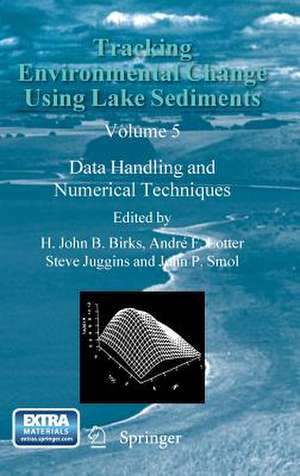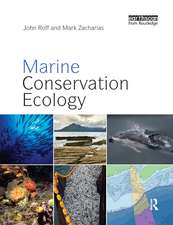Tracking Environmental Change Using Lake Sediments: Data Handling and Numerical Techniques: Developments in Paleoenvironmental Research, cartea 5
Editat de H. John B. Birks, André F. Lotter, Steve Juggins, John P. Smolen Limba Engleză Hardback – 8 apr 2012
| Toate formatele și edițiile | Preț | Express |
|---|---|---|
| Paperback (1) | 921.80 lei 38-44 zile | |
| SPRINGER NETHERLANDS – 23 aug 2016 | 921.80 lei 38-44 zile | |
| Hardback (1) | 1133.61 lei 6-8 săpt. | |
| SPRINGER NETHERLANDS – 8 apr 2012 | 1133.61 lei 6-8 săpt. |
Din seria Developments in Paleoenvironmental Research
- 18%
 Preț: 955.56 lei
Preț: 955.56 lei - 15%
 Preț: 650.86 lei
Preț: 650.86 lei - 18%
 Preț: 948.16 lei
Preț: 948.16 lei - 15%
 Preț: 664.43 lei
Preț: 664.43 lei - 24%
 Preț: 818.76 lei
Preț: 818.76 lei - 15%
 Preț: 647.40 lei
Preț: 647.40 lei - 15%
 Preț: 671.14 lei
Preț: 671.14 lei - 18%
 Preț: 805.92 lei
Preț: 805.92 lei -
 Preț: 409.13 lei
Preț: 409.13 lei - 15%
 Preț: 723.83 lei
Preț: 723.83 lei - 24%
 Preț: 912.89 lei
Preț: 912.89 lei - 24%
 Preț: 1164.38 lei
Preț: 1164.38 lei - 18%
 Preț: 941.82 lei
Preț: 941.82 lei - 20%
 Preț: 612.58 lei
Preț: 612.58 lei - 15%
 Preț: 653.33 lei
Preț: 653.33 lei - 18%
 Preț: 969.44 lei
Preț: 969.44 lei - 15%
 Preț: 650.37 lei
Preț: 650.37 lei - 9%
 Preț: 1420.99 lei
Preț: 1420.99 lei
Preț: 1133.61 lei
Preț vechi: 1382.45 lei
-18% Nou
Puncte Express: 1700
Preț estimativ în valută:
216.94€ • 225.11$ • 181.33£
216.94€ • 225.11$ • 181.33£
Carte tipărită la comandă
Livrare economică 15-29 martie
Preluare comenzi: 021 569.72.76
Specificații
ISBN-13: 9789400727441
ISBN-10: 9400727445
Pagini: 734
Ilustrații: XVIII, 745 p.
Dimensiuni: 155 x 235 x 50 mm
Greutate: 1.16 kg
Ediția:2012
Editura: SPRINGER NETHERLANDS
Colecția Springer
Seria Developments in Paleoenvironmental Research
Locul publicării:Dordrecht, Netherlands
ISBN-10: 9400727445
Pagini: 734
Ilustrații: XVIII, 745 p.
Dimensiuni: 155 x 235 x 50 mm
Greutate: 1.16 kg
Ediția:2012
Editura: SPRINGER NETHERLANDS
Colecția Springer
Seria Developments in Paleoenvironmental Research
Locul publicării:Dordrecht, Netherlands
Public țintă
ResearchCuprins
Part I: Introduction, Numerical Overview, and Data-Sets.- Part II: Numerical Methods for the Analysis of Modern and Stratigraphical Palaeolimnological Data.- Part III: Numerical Methods for the Analysis of Stratigraphical Palaeolimnological Data.- Part IV: Case Studies and Future Developments in Quantitative Palaeolimnology.
Recenzii
From the reviews:
“The book is divided into Parts I-IV with a total of 21 chapters. … All figures, tables and equations are well-reproduced and enhance the text substantially. This book is a unique and timely publication within the field of palaeoenvironmental research. … all of the chapters have substantial reference lists. The content is also made accessible to new researchers through the 41-page glossary and a detailed index. … an essential reference for postgraduate students and postdoctoral researchers in the early stages of their careers.” (Adrian Palmer, The Holocene, February, 2013)
“Each chapter provides basic concepts of the method presented, details concerning data preparation and transformation, a thorough discussion supported by case studies, and recommendations regarding potential use in palaeolimnological studies. … the content is well illustrated by figures and tables of excellent quality. A very important part of each chapter is a list of up-to-date references and suitable software packages. … it is a priceless source of knowledge which should be among must-read books on every palaeolimnologist’s bookshelf.” (Wojciech Tylmann, Geologos, Vol. 19 (4), 2013)
“The book is divided into Parts I-IV with a total of 21 chapters. … All figures, tables and equations are well-reproduced and enhance the text substantially. This book is a unique and timely publication within the field of palaeoenvironmental research. … all of the chapters have substantial reference lists. The content is also made accessible to new researchers through the 41-page glossary and a detailed index. … an essential reference for postgraduate students and postdoctoral researchers in the early stages of their careers.” (Adrian Palmer, The Holocene, February, 2013)
“Each chapter provides basic concepts of the method presented, details concerning data preparation and transformation, a thorough discussion supported by case studies, and recommendations regarding potential use in palaeolimnological studies. … the content is well illustrated by figures and tables of excellent quality. A very important part of each chapter is a list of up-to-date references and suitable software packages. … it is a priceless source of knowledge which should be among must-read books on every palaeolimnologist’s bookshelf.” (Wojciech Tylmann, Geologos, Vol. 19 (4), 2013)
Notă biografică
H. John B. Birks is Professor in Quantitative Ecology and Palaeoecology at the Department of Biology, University of Bergen and the Bjerknes Centre for Climate Research (Norway), Emeritus Professor at the Environmental Change Research Centre, University College London, and Distinguished Visiting Fellow at the School of Geography and the Environment, University of Oxford. He was Adjunct Professor in the Department of Biology at Queen’s University (Kingston, Ontario) until 2011. André F. Lotter is Professor in Palaeoecology at the Institute of Environmental Biology of Utrecht University (The Netherlands), where he is head of the Laboratory of Palaeobotany and Palynology. Steve Juggins is a Senior Lecturer and Head of Department in the School of Geography, Politics and Sociology, Newcastle University where he teaches and researches issues of aquatic pollution, diatom analysis, palaeolimnology, and quantitative palaeoecology. John P. Smol is a Professor in the Department of Biology at Queen’s University (Kingston, Ontario), where he also holds the Canada Research Chair in Environmental Change. He co-directs the Paleoecological Environmental Assessment and Research Lab (PEARL). John Smol was the founding editor of the international Journal of Paleolimnology (1987-2007) and is current editor of the journal Environmental Reviews, and editor of the Developments in Paleoenvironmental Research book series.
Textul de pe ultima copertă
Numerical and statistical methods have rapidly become part of a palaeolimnologist’s tool-kit. They are used to explore and summarise complex data, reconstruct past environmental variables from fossil assemblages, and test competing hypotheses about the causes of observed changes in lake biota through history. This book brings together a wide array of numerical and statistical techniques currently available for use in palaeolimnology and other branches of palaeoecology.
Caracteristici
First book covering full range of modern data-analytical and statistical techniques used in paleolimnology and paleoecology Features exploratory data analysis, error estimation, clustering, ordination and modern statistical learning techniques Includes case studies on human impact, lake development and climate change ?















